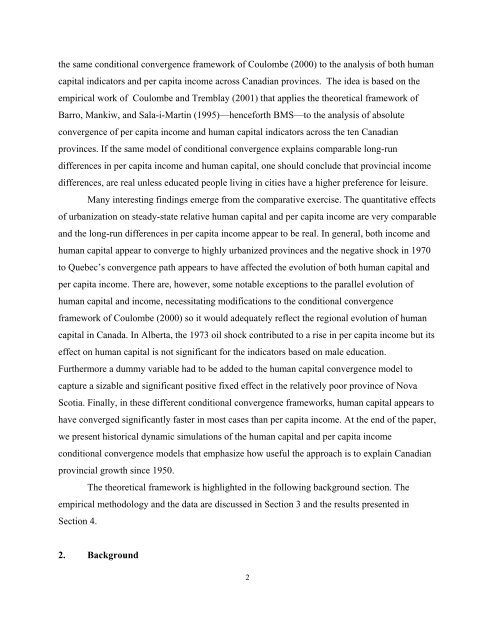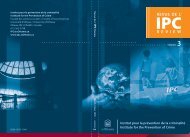0105E - Faculty of Social Sciences
0105E - Faculty of Social Sciences
0105E - Faculty of Social Sciences
Create successful ePaper yourself
Turn your PDF publications into a flip-book with our unique Google optimized e-Paper software.
the same conditional convergence framework <strong>of</strong> Coulombe (2000) to the analysis <strong>of</strong> both human<br />
capital indicators and per capita income across Canadian provinces. The idea is based on the<br />
empirical work <strong>of</strong> Coulombe and Tremblay (2001) that applies the theoretical framework <strong>of</strong><br />
Barro, Mankiw, and Sala-i-Martin (1995)—henceforth BMS—to the analysis <strong>of</strong> absolute<br />
convergence <strong>of</strong> per capita income and human capital indicators across the ten Canadian<br />
provinces. If the same model <strong>of</strong> conditional convergence explains comparable long-run<br />
differences in per capita income and human capital, one should conclude that provincial income<br />
differences, are real unless educated people living in cities have a higher preference for leisure.<br />
Many interesting findings emerge from the comparative exercise. The quantitative effects<br />
<strong>of</strong> urbanization on steady-state relative human capital and per capita income are very comparable<br />
and the long-run differences in per capita income appear to be real. In general, both income and<br />
human capital appear to converge to highly urbanized provinces and the negative shock in 1970<br />
to Quebec’s convergence path appears to have affected the evolution <strong>of</strong> both human capital and<br />
per capita income. There are, however, some notable exceptions to the parallel evolution <strong>of</strong><br />
human capital and income, necessitating modifications to the conditional convergence<br />
framework <strong>of</strong> Coulombe (2000) so it would adequately reflect the regional evolution <strong>of</strong> human<br />
capital in Canada. In Alberta, the 1973 oil shock contributed to a rise in per capita income but its<br />
effect on human capital is not significant for the indicators based on male education.<br />
Furthermore a dummy variable had to be added to the human capital convergence model to<br />
capture a sizable and significant positive fixed effect in the relatively poor province <strong>of</strong> Nova<br />
Scotia. Finally, in these different conditional convergence frameworks, human capital appears to<br />
have converged significantly faster in most cases than per capita income. At the end <strong>of</strong> the paper,<br />
we present historical dynamic simulations <strong>of</strong> the human capital and per capita income<br />
conditional convergence models that emphasize how useful the approach is to explain Canadian<br />
provincial growth since 1950.<br />
The theoretical framework is highlighted in the following background section. The<br />
empirical methodology and the data are discussed in Section 3 and the results presented in<br />
Section 4.<br />
2. Background<br />
2
















